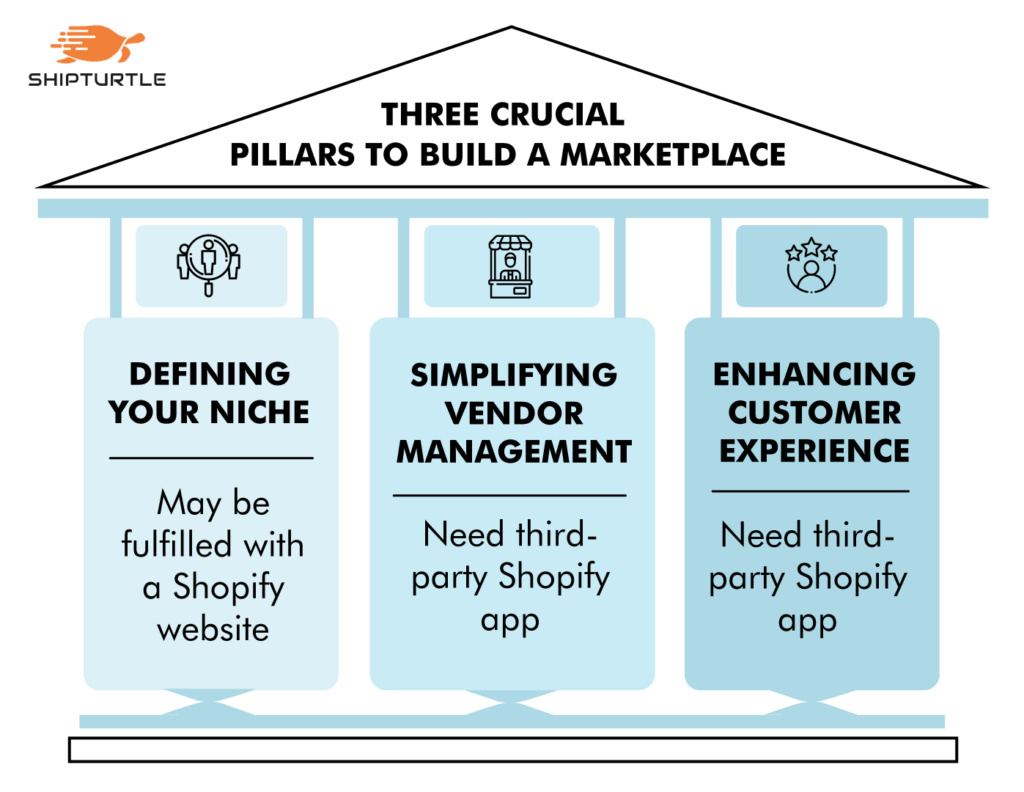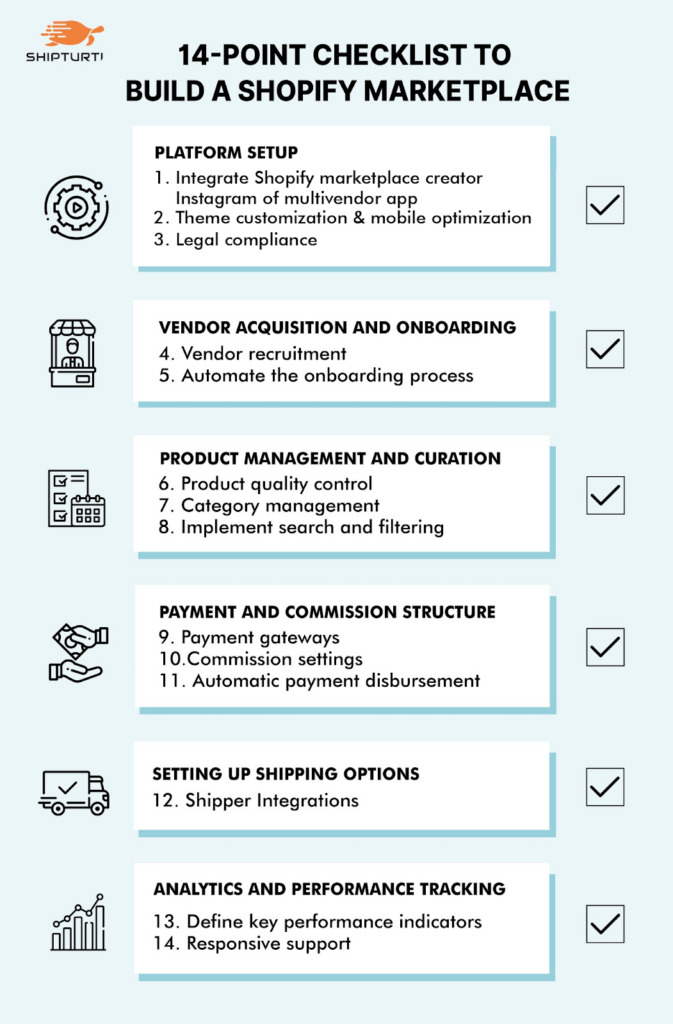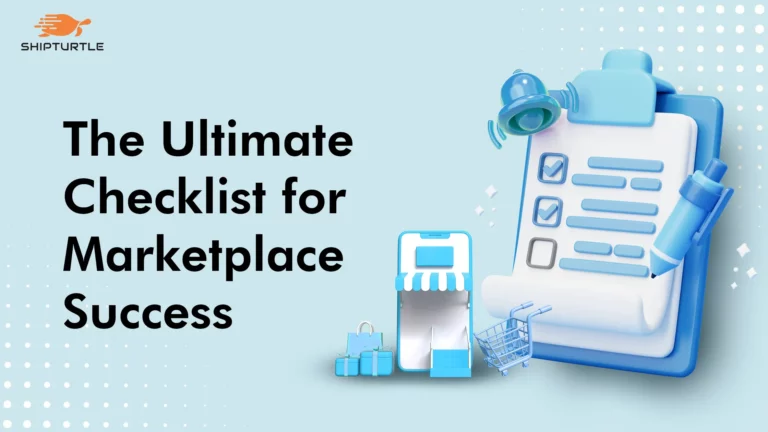10+ Ultimate Checklist For Multi-Vendor Marketplace on Shopify
Shopify is the leading e-commerce platform as it empowers anyone, tech-savvy or not, to confidently build a marketplace website and manage multiple vendors.
Consider your Shopify multi vendor marketplace as a bridge connecting buyers and multiple sellers.
But how do you ensure your multi vendor marketplace for Shopify store shines among countless bridges?
The answer lies in defining three crucial pillars of building an online store:
- Identifying your niche,
- Simplifying vendor management and
- Enhancing customer experience.

More often than not, manufacturers and traders limit their business by only fulfilling the first pillar – defining their business niche and creating a unique value proposition. It could be because the out-of-box features cannot fulfill the technical requirements of the other two pillars.
Without a multivendor marketplace app for Shopify, you cannot register sellers, manage vendor stores from a single dashboard, and calculate individual commissions and global commissions.
Additionally, there is a shortfall in order processing functionalities, with the absence of automated labeling, shipping, tracking, and invoicing features. Furthermore, there are no essential marketing and sales features, including built-in email marketing, abandoned cart recovery, and upselling tools.
As your multi-vendor store expands into a fully fledged marketplace, you may face a potential scalability issue.
Fortunately, you can use a multi-vendor app like Shipturtle to seamlessly convert your ecommerce into a fully functioning marketplace. Let’s explore this further.
Convert Shopify Store to a Multivendor Marketplace Using Our 14-Point Checklist

Building a multi vendor marketplace website requires careful planning and execution. Our proven checklist will guide you through the essential steps and ensure a smooth launch and sustained growth.
| Platform Setup | 1. Integrate Shopify marketplace creator 2. Theme customization & mobile optimization 3. Legal compliance |
| Vendor Acquisition and Onboarding | 4. Vendor onboarding 5. Automate the onboarding process |
| Product Management and Curation | 6. Product quality control 7. Category management 8. Implement search and filtering |
| Payment and Commission Structure | 9. Payment gateways 10. Commission settings 11. Automatic payment disbursement |
| Setting Up Shipping Options | 12. Shipper Integrations |
| Analytics and Performance Tracking | 13. Define key performance indicators 14. Responsive support |
I. E-commerce platform setup
Once you’ve defined your niche and value proposition, it’s time to build your online marketplace.
1. Choose the right multi-vendor app:
Shopify app store hosts a range of plugins to transform your online store. Popular options include:
- Multi-vendor marketplace apps: Onport, Puppet Vendors, or Flxpoint offer features like vendor onboarding, product listing management, and commission tracking.
- Inventory management apps: Shopify multi-vendor plugins like Syncio, Ampiflow, or SyncLogic sync your products and inventory in real time between multiple stores.
- Shipping and fulfillment apps: Apps like Shipway, Pluginhive, or Indian Logistics Services streamline order fulfillment by automating tasks like shipping label generation and tracking.
- Brand partnerships: Tools like Carro, Disconetwork, or Shopcanal enable you to connect with similar brands in your niche to create a marketplace.
- Self-hosted marketplace software: Tools like Sharetribe, CS Kart, or Webkul can help you attract new customers, boost engagement, and optimize your platform for search engines.
ShipTurtle is a great app and popular choice plugin for building a multi-vendor marketplace with Shopify. It offers a one-stop solution for vendor and order management that automates your existing marketplace.
2. Theme selection & mobile optimization:
Your theme sets the visual tone for your marketplace.
Choose a theme on the Shopify website builder that is responsive, visually appealing, and functionally rich.
Your chosen theme should support features like vendor storefronts, product search filters, and a clear checkout process and at the same time, ensure a seamless experience across all devices that reflects your brand identity.
Explore top themes for your multi-vendor store here.
3. Legal considerations:
Consult legal professionals to ensure your marketplace complies with relevant e-commerce and data privacy regulations. It includes terms of service, privacy policies, and dispute resolution procedures.
II. Vendor Acquisition and Onboarding Multiple Sellers
Your marketplace is only as vibrant as the vendors who call it home. Inviting sellers and ensuring their smooth onboarding are crucial steps in building an active community and delivering on your value proposition.
Here’s how to approach each seller:
4. Recruitment of numerous vendors:
Develop recruitment materials like brochures, website landing pages, and email templates to effectively convey the unique advantages of contributing to your marketplace business model. Showcase success stories from existing vendors through testimonials and case studies to build trust and credibility among potential partners.
5. Onboarding & seller vetting:
Start by simplifying vendor registration, ensuring a seamless process of adding sellers and onboarding experience with clear instructions and user-friendly storefronts.
Provide dedicated onboarding support by assigning a point of contact to address questions and concerns and guide vendors throughout the onboarding process.
Learn more about how ShipTurtle can automate onboarding and seller vetting here. Moreover, ShipTurtle allows you to set individual commissions and global concerning price modifications and more.
III. Product Management and Curation
A successful marketplace thrives on a compelling selection of products that resonate with your target audience. Here’s how you can go about it:
6. Product quality control:
Define comprehensive guidelines for product descriptions, images, pricing, and shipping practices, ensuring that vendors accurately portray their offerings and meet the quality expectations set by your platform.
Additionally, provide vendors with valuable resources, such as training materials and best practices, to assist them in creating compelling product listings and adhering to the defined quality standards. ShipTurtle keeps a robust history of every change made by the users for troubleshooting purposes.
7. Category management:
Implementing advanced search filters, such as those for price range, product features, and brand names, can significantly assist customers in quickly locating the specific items they are seeking.
Another effective strategy is highlighting curated collections or “staff picks” that showcase unique offerings, new arrivals, or products aligned with specific trends or customer interests.
8. Automated search and filtering:
This involves ensuring that the search bar is easily accessible, provides auto-suggestions, and delivers accurate results based on relevant keywords and product attributes.
By incorporating these features, you not only streamline the product discovery process for your customers but also add a personalized touch to their shopping experience, encouraging engagement and exploration within your platform.
Additionally, ShipTurtle’s revolutionary Vendor Website Sync feature is a game-changer solution to keep your product, inventory, and order information in sync. Furthermore, you can implement a Branded Tracking Page after placing an order for potential upselling and cross-selling opportunities.
IV. Payment and Commission Structure
Establishing a clear and transparent payment and commission structure is crucial for the long-term success of your Shopify marketplace.
Here’s how you can ensure fair compensation for vendors, a predictable revenue stream for you, and a seamless experience for customers:
9. Payment gateways:
Choose third-party Shopify marketplace apps to integrate secure and reliable payment gateways to facilitate vendor and customer transactions. Be transparent about any transaction fees charged to buyers or vendors, ensuring no hidden costs surprise them at checkout.
10. Commission settings:
Begin by determining commission rates, taking into account factors such as product category, profit margin, or vendor performance.
11. Automatic payment disbursements:
Set up automated payment disbursements to vendors based on their sales and commission structure.
To streamline operations and maintain accuracy, leverage third-party apps like ShipTurtle to automate commission calculations, set commissions at various levels, from Global to Vendor, Category, and Product specifics, and generate commission invoices.
V. Setting Up Shipping Options
Shopify may allow you to track the fulfillment status of an order and provide details of the AWB (Airway Bill) only. However, all other tasks, such as obtaining courier rates, creating labels, and tracking, must be handled manually.
This process is notably labor-intensive and, based on our experience, demands at least 5-10 minutes for each order processed.
12. Shipper integrations:
You can use the ShipTurtle plugin on your Shopify marketplace to seamlessly integrate with 200+ courier partners, including FedEx, Bluedart, DHL, Delhivery, and more.
VI. Analytics and Performance Tracking
Eventually, you need reliable and insightful analytics to steer your Shopify marketplace toward success. Here’s the best way to go about it:
13. Define key performance indicators:
You may use in-built analytics on Shopify to measure site performance. However, you can explore third-party apps on Shopify to analyze vendor performance, customer acquisition, and retention better.
14. Responsive support:
Offer multiple contact channels, including email, live chat, phone support, and social media messaging, to accommodate diverse customer preferences and ensure efficient communication.
Using ShipTurtle on Shopify, you can establish clear expectations for response times, striving to address customer inquiries promptly and effectively.
How to Get Started?
Building a marketplace on Shopify is a low-risk option for start-ups to establish a sales channel before setting up a manufacturing unit. If you are that someone, you should consider scheduling a free call with our e-commerce experts.
Even though you might not currently require our services, feel free to view our success stories. You can use our live chat option that appears at the bottom right of your screen to explore more.
Let’s explore the possibilities of collaborating and creating something exceptional together!





